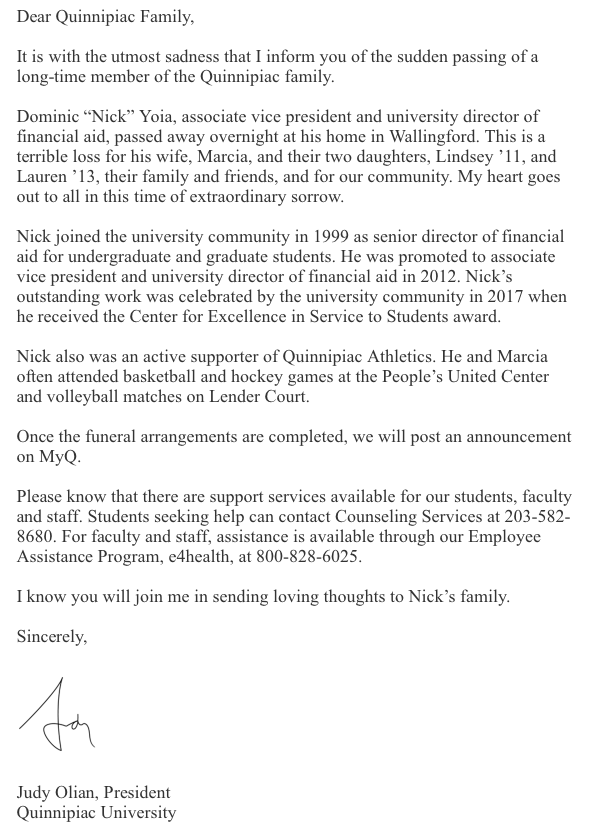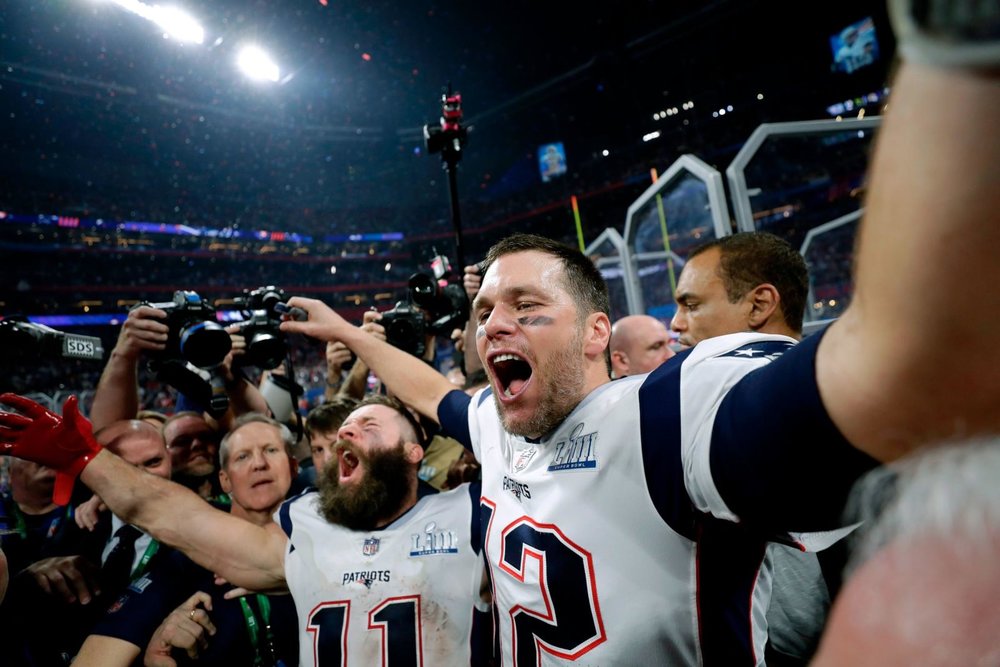By Hannah Cotter
Wake up. Check phone. Stand up. Check phone. Eat breakfast. Check phone.
No, this isn’t a weird remix to Kendrick Lamar’s “Swimming Pools (Drank).” This is what a normal morning looks like for me, according to the Screen Time feature on my iPhone.
The latest iPhone update for iOS 12 gives you access to Apple’s Screen Time suite, designed to give you a better idea of how much time you’re spending on your phone and giving you the option to limit time spent on certain apps.
The feature lurks quietly in the background while you’re scrolling through your Instagram feed or checking your emails on Outlook, silently adding minutes to your end of the week report.
“Your screen time was up 15% last week,” it tells me, and I automatically feel… shame?
I’ve become painfully aware of my social media addiction, but with a 24/7 media barrage of politics, pop culture and sports, it’s hard to look away. All I need to know, it seems, is in the palm of my hand.
Checking our phones has become second nature, like scratching an itch or touching our hair.
According to the Pew Research Center, 44% of teenagers in the United States say they check their phones as soon as they wake up. 18% of them say they feel obligated to respond to messages or notifications immediately.
The charts below depict the percentage of U.S. teens who say they…
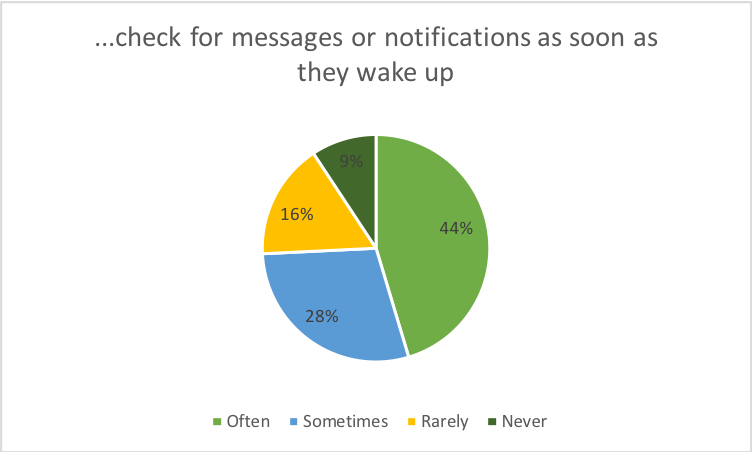
Source: Pew Research Center

Source: Pew Research Center
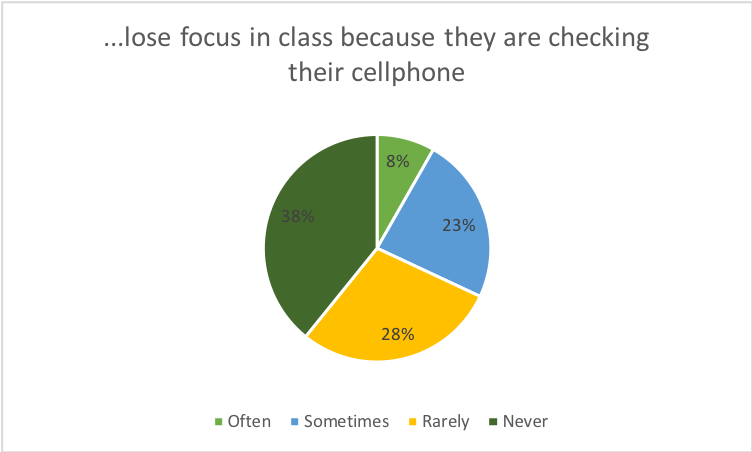
Source: Pew Research Center
People are quick to blame millennials for social media dependency, but that same study suggests 60% of parents also feel compelled to respond to messages right away.
Check out the parents who say they…
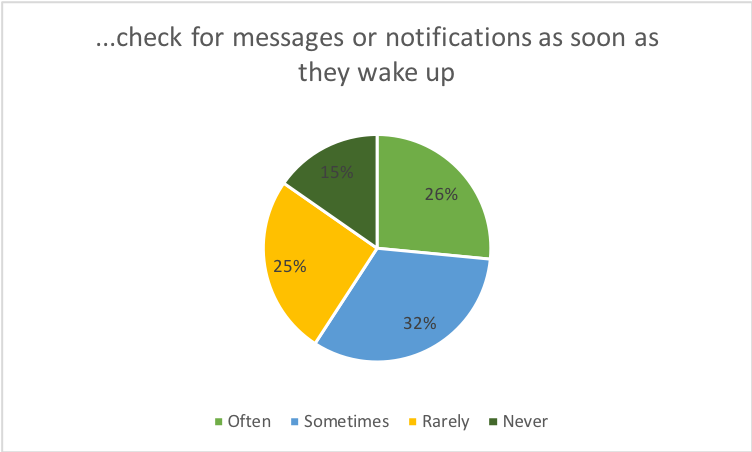
Source: Pew Research Center
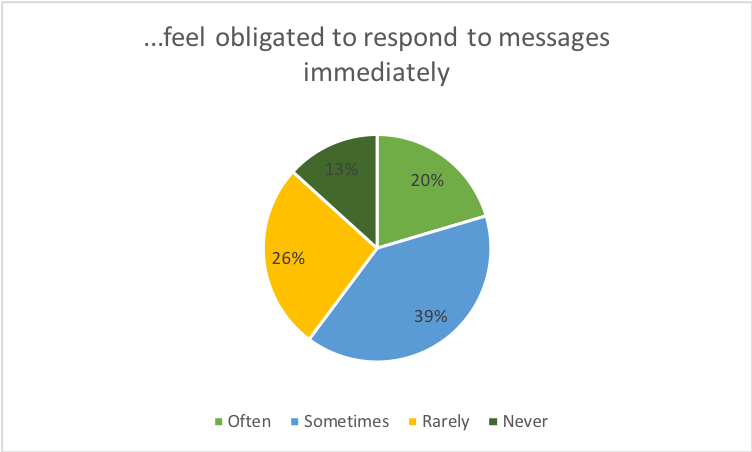
Source: Pew Research Center

Source: Pew Research Center
In a sense, our digital relationships are starting to take priority over our real life ones.
Though social media has many great assets: making communication easier, galvanizing human capital and spreading news and information in a quick and effective way, our dependence on it is starting to affect our lives off the screen.
How many times have you sat in a meeting or in a class where nearly everyone is consumed by what’s on their laptops or smartphones instead of what’s going on in front of them?
According to a 2015 study by Microsoft Corp., people generally lose concentration after eight seconds due to an increasingly digitalized lifestyle on the brain.
“Heavy multi-screeners find it difficult to filter out irrelevant stimuli,” the report reads. “They’re more easily distracted by multiple streams of media.”
Multi-screening is more common than you might think: look around next time you’re watching television with someone. Odds are, they’re juggling whatever you’re watching with whatever’s on their smartphone.
Audrey Rowe, a senior at Quinnipiac University, says she and her roommates oftentimes balance social media with whatever’s on their television.
“A lot of times when I’m watching shows, I’ll find myself on my phone,” Rowe said. “My roommates will do that, too. We’ll be watching something, like sitting on the couch, and we’re on our phones. What’s on the TV is just background noise and I’m looking through Instagram or Snapchat stories.”
Why?
“I don’t know,” she continued. “It’s so stupid. I want to watch the show, but I’m on my phone because it’s right there. You’re on it so much that it feels natural to be on it even when you’re watching something else. I want to be in touch with what’s going on, I guess.”
I spoke with Adam Alter, a social psychologist and professor at New York University and the author of “Irresistible: The Rise of Addictive Technology and the Business of Keeping us Hooked.” In his book, Alter explores the affects of social media addiction and how we can combat it.
We discussed Twitter and how a lot of people can’t physically get themselves to read more than a headline or a short tweet anymore, thanks to our 280-character attention spans.
“I think it’s easier than every to develop a short attention span,” he said. “Because so few experiences demand more than bite-sized chunks of attention. They’re designed that way because their creators know they’re competing with lots of other experiences that are just as likely to capture our time and attention.”
Social media helps brands go further, faster, cheaper and deeper than any other technology. In the social media landscape, brands are able to hook consumers with ads on Instagram, Twitter and Facebook. Because everyone is already on it, it’s easy for businesses to plant ads in celebrity posts or partner with brands because people are seeing the posts anyway. It’s become one of our generation’s most effective business tools.
For Will Pustari, a video producer, social media is strictly business.
Working at Barstool Sports, a sports and pop culture blog with a heavy presence on Twitter, social media became a major part of his job.
“It’s the only factor in all of the work I’ve done there,” he said. “Keeping up and especially capitalizing on every trend is extremely important. Because anyone can join the social media platform, many topics become oversaturated and diluted, making it all the more difficult to stay on top of what the masses are into at that point in time.”
Because he was always scouring the ‘Net for work-related news, his personal accounts got put on the back burner.
“I was constantly on the prowl for new content and staying on top of trends,” he explained. “So my own social media profiles became inactive for some time, but it didn’t bother me so much since it helped my work life significantly.”
How do we find a balance between social media in our work lives and our personal lives? Can we find a balance between our screen time and our real experiences?
Alter says the key is to relearn how to focus.
“The only way [to relearn to focus] is to be mindful about the issue—to train yourself to avoid a quick fix and to read longform articles and books; to close your browser as you undertake longer tasks; and to take time away from tech and screens to immerse yourself in deeper work and thought.”
Check out my podcast, The Goldfish Effect, to hear more stories about social media distraction.
